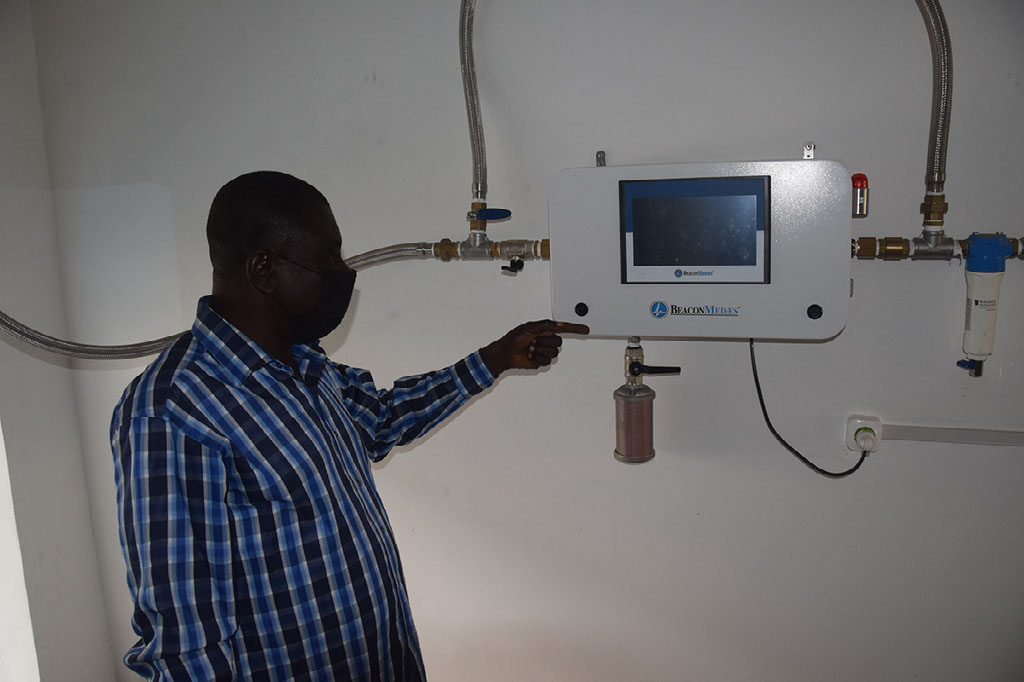A photo story on securing sustainable access to oxygen in DRC, Kinshasa – a project funded by Unitaid and implemented by the World Health Organization (WHO). Text and photo credits: WHO/Eugene Kabambi
In her small office at University Clinics of Kinshasa, nurse Agnès Bisilwala used to have her eyes trained on a row of large gas cylinders.
“In the past, three or four days could go by without enough medical oxygen for our COVID-19 patients in intensive care. Many of them were unable to maintain their oxygenation and succumbed to the virus.”
Agnès Bisilwala
Nurse, Intensive Care Unit
That all changed at the beginning of August 2022 when a new plant began producing essential supplies of high-quality medical oxygen just metres away from nurse Bisilwala’s office within the premises of the University of Kinshasa, where she has headed the intensive care unit for 21 years.
With financial support from Unitaid, the World Health Organization (WHO) has piloted the construction of two medical oxygen production plants in the Democratic Republic of Congo.


The plant at the University Clinics of Kinshasa produces enough oxygen to fill 88 cylinders of 47.2 litres each every day, more than double the hospital’s typical daily need. The second plant is set to become operational within the Sino-Congolese Friendship Hospital, which is located to the southeast of Kinshasa. These two establishments were chosen to house the new oxygen production plants because of their status as reference hospitals capable of supplying other secondary health facilities, as well as for their ability to manage severe cases.
At the height of the pandemic, both hospitals hosted dedicated treatment centres for COVID-19 patients. However, demand for quality oxygen for those in critical condition soon exceeded the centres’ capacity.
“We were using small oxygen concentrators, and it was very difficult to provide enough oxygen for patients in respiratory distress, who can each consume up to ten 50-litre cylinders a day,” said nurse Bisilwala.


A month on from the commissioning of the new plant, Dr Bertain Nsitwa, the project supervisor, reiterates the significant changes it has already brought about.
“Before, we bought the oxygen from a factory in Kingabwa, more than 15 km away. The transport costs were exorbitant, and the oxygen level was only 30% to 50%, which sometimes worsened the state of patients’ health. In contrast, the oxygen supplied by the newly built plant has a purity of 92% to 96%,” he said.
By providing higher quality oxygen at a lower cost and in greater quantities, the new facility will help address shortages across Kinshasa, where demand remains high, even as COVID-19 cases are currently on the decline, according to official statistics.



“This plant can really save lives,” says Faustin Ngankuey, an engineer in charge of operations at the University Clinics of Kinshasa facility.
In anticipation of potential further COVID-19 pandemic waves, work is now underway on a third factory in Goma, the provincial capital of North Kivu. This unit would then be able to provide high-quality medical oxygen to many other medical facilities located in the east of the country, including in the cities of Bukavu, Beni and Butembo, which currently have no such supplies.

“Many lives have been lost and families bereaved due to the dearth of medical oxygen during the COVID-19 pandemic,” said Dr Amédée Prosper Djiguimdé, WHO Representative in the Democratic Republic of the Congo.
While WHO previously provided several dozen medical concentrators for the management of severe cases of the virus in the country, the needs were immense. This important partnership with Unitaid for production in Kinshasa, and very soon in Goma, completely changes the situation.
Dr Amédée Prosper Djiguimdé
WHO Representative in the Democratic Republic of the Congo
In addition to serving COVID-19 patients, increased efforts by Unitaid and WHO to provide oxygen support in the Democratic Republic of the Congo will also contribute to the treatment of other diseases, leading to a much-needed overall strengthening of local health systems.
Photo credits: WHO / Eugene Kabambi
© 2022 Unitaid